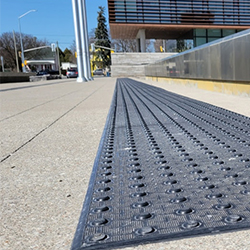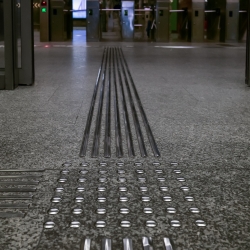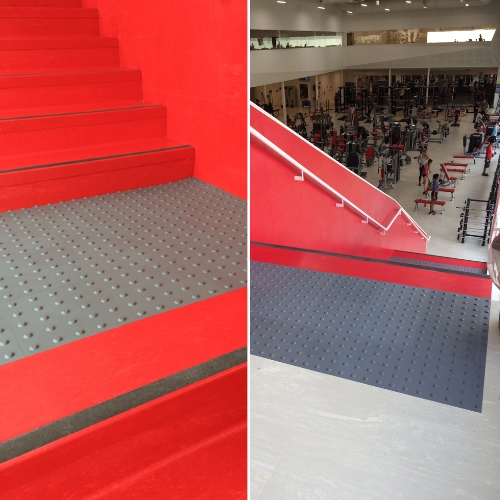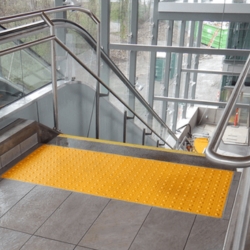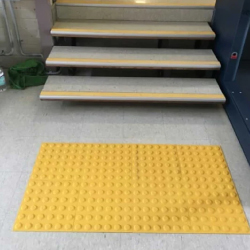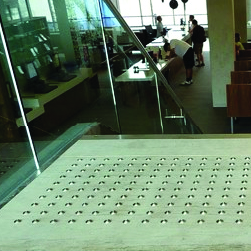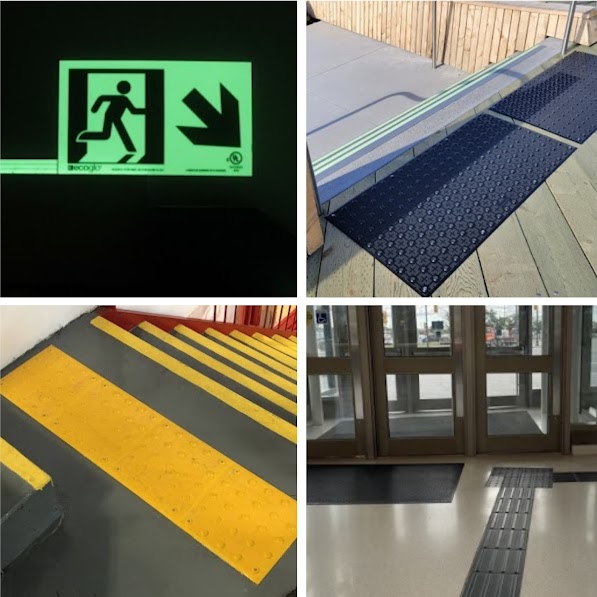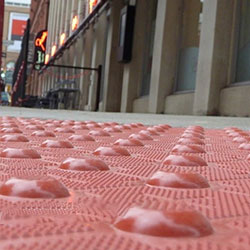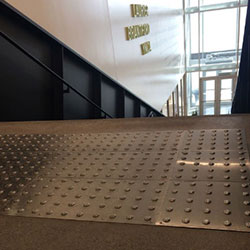When it comes to installing tactile tiles as per Canadian accessibility legislation, contractors and building managers have two primary options - surface-applied tiles or cast-in-place tiles. But what is the difference between these two tactile tile installation methods?
This comprehensive guide will break down the critical distinctions between surface-applied and cast-in-place tiles. We will explore the applications, benefits, drawbacks, costs, and processes involved with each tactile tile system. Let's dive in!
An Introduction to Tactile Tiles
First, let's briefly understand what tactile tiles are and why they are an indispensable accessibility feature.
Tactile tiles, also known as Tactile Walking Surface Indicators (TWSI), are textured ground surface indicators installed in walking areas. These tiles feature raised domes, bars, cones, or a combination of textures that can be detected through canes or underfoot.
As per accessibility regulations like the Accessibility for Ontarians with Disabilities Act (AODA), tactile tiles are mandatory in public spaces. They serve two primary purposes:
- Warning Indicators: Tactile tiles with distinctive patterns like truncated domes alert pedestrians to upcoming hazards like stairs, platform edges, vehicle routes, etc.
- Directional Cues: Tactile tiles with elongated bars or grooves guide users along designated pathways and walking lines in open spaces.
Tactile tiles enhance accessibility and safety for those with visual impairments. They provide non-visual information through touch that enables independent navigation.
Now let's explore the two main installation methods for these indispensable tiles.
Cast-In-Place Tactile Tiles
Cast-in-place tactile tiles are installed directly into freshly poured concrete. The tiles get embedded into the curing concrete, creating a permanent bond when the concrete solidifies.
Here are the key features of cast-in-place tactile tiles:
- Used for New Construction: Cast-in-place tiles are ideal for new buildings and public spaces where concrete surfaces are being created. They can be seamlessly integrated during the construction process.
- Permanent Installation: The concrete cures and hardens around the tactile tile anchors, firmly fixing them in place. This creates a highly durable installation that won't loosen or detach.
- Withstands Heavy Loads: Since they are firmly set in concrete, cast-in-place tiles can withstand extremely heavy foot traffic, machinery, and harsh weather.
- AODA & CSA Compliance: These tiles enable compliance with accessibility regulations when installed correctly as per standards.
- Materials: Cast-in-place tiles are commonly made of durable materials like metals, engineered polymers, and porcelain designed to be integrated with tactile patterns.
- Texture Options: Manufacturers offer cast-in-place tiles with a choice of warning patterns like truncated domes or wayfinding bars.
- Color Choices: To ensure sufficient visual contrast between the tiles and surrounding surfaces, the tiles are available in compliant vibrant colors like safety federal yellow, onyx black, brick red, etc.
- Range of Sizes: Cast-in-place tactile tiles are available in different sizes and shapes to fit the required area. Special corner tiles and radius tiles are also available.
- Installation Process: The tiles are installed into the marked locations when the concrete is still wet and workable. The concrete cures around the tiles, firmly anchoring them in place.
Surface Applied Tactile Tiles
As the name suggests, surface-applied tactile tiles get affixed onto existing concrete or floor surfaces using adhesive and mechanical fasteners. Let's examine their defining features:
- Retrofitting Existing Surfaces: Surface-applied tiles can upgrade accessibility on any existing hard surfaces like sidewalks, pavements, stairs, ramps, etc., without demolition.
- Versatile Applications: They can be installed both indoors and outdoors on surfaces like concrete, terrazzo, steel, tiles, wood, etc.
- Quick Installation: The tiles can be fixed in place within a few hours using adhesive and screws/anchors. This is much faster compared to cast-in-place tiles.
- Cost-Effective: Installation does not involve complex processes like pouring new concrete. This makes surface-applied tiles a very budget-friendly tactile solution.
- Replaceability: Damaged or worn-out surface-applied tiles can be easily replaced by removing the fasteners and adhesive.
- Materials: These tiles are commonly fabricated from durable polymers, metals, porcelain, rubber, and anti-slip composites engineered for surface bonding.
- Texture and Color Options: Surface-applied tiles offer all the texture configurations and color choices, like cast-in-place tiles for visual and tactile contrast.
- Customization: The tiles can be effortlessly cut on-site for creating custom sizes and radius pieces.
- Maintenance: Since the tiles are bonded on top, they provide easy access for inspection, cleaning, and replacement.
- Standards Compliance: When properly installed, surface-applied tiles meet AODA, CSA, and other tactile tile standards.
Cast-In-Place Tiles vs. Surface Applied Tiles
Now that we have explored both tactile tile systems let's compare them across some key parameters:
1. Durability
Cast-in-place tiles are firmly anchored in concrete, making them extremely durable against forces like heavy footfall and vehicular traffic. Surface-applied tiles adhere to the substrate, so heavy loads can cause the bond to fail over time.
2. Costs
Cast-in-place tiles require excavating concrete and pouring fresh concrete, adding labor and material costs. Surface-applied tiles only need adhesive, fasteners, and basic tools, making them a budget-friendly option.
3. Installation
Cast-in-place tiles need accurate installation into wet concrete and involve curing time. Surface-applied tiles can be fixed with basic DIY skills using adhesive and drills.
4. Aesthetics
Cast-in-place tiles seamlessly integrate into the walking surface with no visible gap between the tile and concrete. Surface-applied tiles have slight edges between the tile and substrate.
5. Longevity
Properly installed cast-in-place tiles can easily last 25+ years. Surface-applied tiles have a lifespan of around 5-8 years before replacement is needed.
6. Standards Compliance
Both tactile systems can comply with accessibility standards if engineered and installed according to specifications.
7. Ideal Applications
- Cast-in-place - new construction, outdoors, high-traffic areas
- Surface applied - retrofits, indoors, low/medium traffic areas
8. Maintenance
Replacing damaged cast-in-place tiles is tedious. Surface-applied tiles can be swapped out easily when required.
Making the Optimal Tactile Tile Choice
When selecting tactile tiles, consider the following factors:
- Indoor or outdoor installation
- New construction or retrofitting
- Expected foot traffic and loading
- Ability to replace damaged tiles
- Budget
- Aesthetic needs
- Applicable accessibility standards
Review your unique requirements against the benefits of each tactile system to make the ideal choice. Expert suppliers like Tactile Solutions Canada can also guide you in picking the right tactile tiles tailored to your project.
AODA & CSA Compliant Tactile Systems from Tactile Solutions Canada
As Canada's leading tactile tile supplier, Tactile Solutions provides the most extensive selection of cast-in-place and surface-applied tactile systems to create accessible public spaces per regulations.
Our cast-in-place tile range includes:
- AccessTile Cast-In-Place Attention Domes
- AccessTile Cast-In-Place Wayfinding Bars
- Armor Tile Tactile System Cast-In-Place
- Advantage Tactile Systems Cast Iron
- Replaceable Cast-Iron Cast-in-Place
- Cast-In-Place Tactile Wayfinding Plate
The surface-applied tiles we offer consist of:
- Armor Tile Tactile System Surface Applied
- AccessTile Surface Applied Attention Domes
- AccessTile Surface Applied Wayfinding Bars
- Eon Tile Rubber Attention Domes Tile
- Elan Tile Porcelain Attention Domes Tile
- Advantage Tactile Systems One Plate with Domes
All our tiles are:
- Engineered for unparalleled durability and weather resistance
- Available in multiple standard and custom sizes
- Compliant with AODA, CSA B651, ISO, and building code tactile requirements
- Backed by 5+ year manufacturer warranties
Get in touch with Tactile Solution Canada team today for expert guidance on selecting and installing the optimal tactile tiles for your next public space project.

